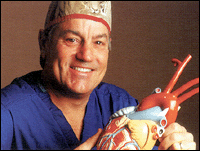For John “Chip” Oswalt, M.D.
In 1967, Dr. Donald Ross, an accomplished surgeon in England, was the first surgeon to perform an effective aortic valve replacement as an alternative to the traditional mechanical valve being used. Ten years ago, John “Chip” Oswalt, M.D., an accomplished surgeon in Austin, Texas, became the first in the state to perform this same aortic valve replacement procedure. Dr. Oswalt says, “It’s an ideal operation because it doesn’t place anything inside that obstructs flow. It’s very physiologic in that manner.”

Known as the “Ross Procedure,” this complex operation takes about three hours to perform as opposed to the two hours needed for a mechanical valve replacement. The surgeon takes the pulmonary artery artery and valve and moves them over into the aortic position for the valve replacement. A human cadaveric pulmonary valve is put in place of the patient’s pulmonary valve.
The Ross Procedure is used primarily for neonates, infants, young people who are very active and don’t want to be on medication (blood thinners) for the rest of their lives, young women in their child-bearing years (this procedure allows them to have children), and middle-aged people who are active. Patient qualifications include how long the valve will need to last (older patients could have a mechanical or pig valve) and possible use of blood thinners. It is used in young children because the living valve will grow with the child. No other valve replacement option can do this. It offers a lot of versatility because it is flexible living tissue. In theory, this procedure should last a lifetime.
Dr. Oswalt, president of Cardiothoracic and Vascular Surgeons and a partner in Heart Hospital of Austin, is the lead surgeon on this procedure and is well respected for his work. He has performed an estimated 150 procedures in Central Texas and across the United States. Cardiothoracic and Vascular Surgeons are among the top four in the nation for highest volume of the Ross Procedure. Dr. Oswalt often treats patients who live outside Texas. Dr. Oswalt added, “I get a lot of patients who decide to come here and have the surgery from around the United States because of reading about the Ross Procedure on our website.”
Because he is such a leader in the Ross Procedure, Dr. Oswalt is often invited to different hospitals across America to help surgeons perform their first Ross. He trains and participates in Teaching Symposiums as well. Dr. Oswalt comments, “I not only enjoy the opportunity to teach someone, but I really enjoy seeing other hospitals, their operating rooms, how they do things, and being around other surgeons. In addition to teaching, it allows me to learn a lot.” The symposiums often involve a live teleconference in which 100-150 surgeons view Dr. Oswalt on a monitor as he performs the Ross Procedure. They can interact verbally with Dr. Oswalt as he is operating which allows for very direct surgical teaching.
This procedure took about twenty years to catch on in the United States because American physicians wanted to see Dr. Ross’ data to verify that it was an effective valve replacement procedure. Twenty years ago, American physicians had developed a replacement procedure using pig valves, which took 15-20 years to follow-up. They realized it was failing after 10-15 years and an alternative was necessary.
The Ross Procedure carries a higher risk for patients than mechanical valve replacement because it is a double valve replacement rather than a single valve replacement procedure. The patient can expect to stay 3-4 days in the hospital. The healing process involves the bones healing rather than the heart.
